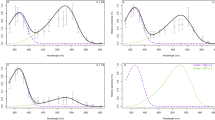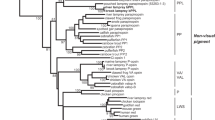Abstract
DARTNALL1 has recently reported extracting what he describes as a new visual pigment from the retina of the South African clawed toad, Xenopus laevis. It is a purple substance, which in Dartnall's preparations has an absorption maximum (λmax.) at 514–516 mμ. Its difference spectrum—the difference in absorption between it and the products of its bleaching—has λmax. 521 μ at pH. about 8.6. Dartnall argues, largely on the basis of analogies with the behaviour of other types of preparation, that the absorption maximum of the Xenopus pigment in reality lies at 519 μ. I see no reason, however, for rejecting his measurements, which are as stated. They show the properties of the Xenopus pigment to be intermediate between those of rhodopsin and porphyropsin. The absorption spectrum of rhodopsin ordinarily has λmax. 500 ± 2mμ, that of porphyropsin λmax. 522 ± 2 mμ. The Xenopus pigment, with λmax. about 515 mμ, might on this basis consist of a mixture of about 70 per cent porphyropsin and 30 per cent rhodopsin. Its difference spectrum is similarly intermediate : λmax. of rhodopsin lies at about 500–502 mμ., that of porphyropsin at about 525–530 mμ. in such mildly alkaline solutions as Dartnall employed; so that again the Xenopus pigment, with difference λmax. 521 mμ, appears to be a mixture of about two-thirds to four-fifths porphyropsin with one-third to one-fifth rhodopsin.
This is a preview of subscription content, access via your institution
Access options
Subscribe to this journal
Receive 51 print issues and online access
$199.00 per year
only $3.90 per issue
Buy this article
- Purchase on Springer Link
- Instant access to full article PDF
Prices may be subject to local taxes which are calculated during checkout
Similar content being viewed by others
References
Dartnall, H. J. A., J. Physiol., 125, 25 (1954).
Wald, G., J. Gen. Physiol., 21, 795 (1937–38); 22, 775 (1938–39).
Wald, G., J. Gen. Physiol., 22, 391 (1938–39)
Cawley, J. D., Robeson, C. D., Weisler, L., Shantz, E. M., Embree, N. D., and Baxter, J. G., Science, 107, 346 (1948). Shantz, E. M., Science, 108, 417 (1948).
Dartnall, H. J. A., J. Physiol., 116, 257 (1952).
Wald, G., Ann. Rev. Biochem., 22, 497 (1953).
Wald, G., J. Gen. Physiol., 25, 331 (1941–42).
Wald, G., J. Gen. Physiol., 25, 235 (1941–42).
Wald, G., Harvey Lectures, 41, 117 (1945–46): “Biochemical Evolution”, in “Modern Trends in Physiology and Biochemistry” 337 (E. S. G. Barron, editor) (Academic Press, New York. 1952).
Author information
Authors and Affiliations
Rights and permissions
About this article
Cite this article
WALD, G. Visual Pigments and Vitamins A of the Clawed Toad, Xenopus laevis. Nature 175, 390–391 (1955). https://doi.org/10.1038/175390a0
Issue Date:
DOI: https://doi.org/10.1038/175390a0
Comments
By submitting a comment you agree to abide by our Terms and Community Guidelines. If you find something abusive or that does not comply with our terms or guidelines please flag it as inappropriate.



